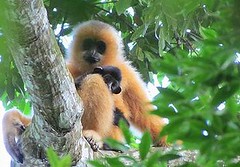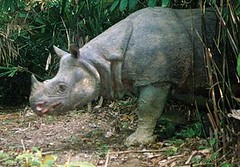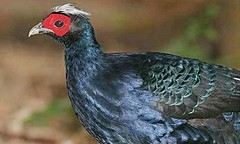科學家11日在世界自然保育聯盟(IUCN)舉辦的「世界保育大會」上,首次名列100個面臨高度滅絕危機的物種。
這些物種裡,很多都對人類沒什麼用處:不能吃、不能藥用或任何其他用途,牠們只是和其他生命一起活在地球上。編輯這項清單的科學家表示,人類必須決定是要保留牠們的生命,或者讓牠們靜靜地消失。
IUCN物種存續委員會的8000多位科學家,共同辨別出100種地球上嚴重受威脅的動物、植物和真菌。研究人員將這份報告集結成書——《無價之寶或一文不值?》,由倫敦動物學會(ZSL)和IUCN在9月11日的世界保育大會發表。IUCN也負責編撰具權威性的瀕危物種紅皮書。
 有些瀕危物種的名稱已經很少耳聞,牠們是扁鮫、自殺棕櫚、黑嘴端鳳頭燕鷗、海南長臂猿、越南獅鼻猴、狨毛原狐猴、阿拉比卡薔薇、金尾象鼩。即便過去因為普遍而被命名為「普通鋸鮫」的魚種,現在也名列嚴重極危物種。
有些瀕危物種的名稱已經很少耳聞,牠們是扁鮫、自殺棕櫚、黑嘴端鳳頭燕鷗、海南長臂猿、越南獅鼻猴、狨毛原狐猴、阿拉比卡薔薇、金尾象鼩。即便過去因為普遍而被命名為「普通鋸鮫」的魚種,現在也名列嚴重極危物種。
ZSL的布特切爾(Ellen Butcher)是該報告的作者之一,他表示,「所有名列的物種都是特殊且無可取代,一旦消失,再多的錢也無法挽回。然而,如果我們立即採取行動,也就給牠們一個生存奮鬥的機會。但這需要社會共同支持『所有物種本來就有生存權』的道德和倫理信念。」
報告共同作者、 ZSL保育主任貝利(Jonathan Baillie)也表示,「目前慈善團體和保育運動越來越傾向『大自然能為我們做什麼』的策略,因此根據物種和野外棲息地能為人類提供什麼服務,來評量其重要與否。」「這種態度讓拯救嚴重瀕危物種的保育人士處境更加艱困,我們必須做出重要的道德與倫理抉擇:這些物種是否有生存權,以及我們是否有權讓牠們滅絕?」
英國皇室威廉王子在書中表示:「這本書不只告訴我們哪些物種瀕臨絕種,還指出如何拯救牠們,它也挑戰我們為未來世代保留無價自然資源的意願。」
以下是幾種名列極危物種的哺乳動物:
 爪哇犀牛(Rhinoceros sondaicus):曾經分佈最廣的亞洲犀牛,由於偷獵犀牛角用於傳統療法,目前已成為全世界最大的罕見哺乳動物。一支犀牛角在黑市可以賣到三萬美元。在印尼爪哇西部烏戎庫隆國家公園裡的一個野生族群,只剩40隻。第二個族群原本在越南的吉仙國家公園,但在2011年已證實絕跡。
爪哇犀牛(Rhinoceros sondaicus):曾經分佈最廣的亞洲犀牛,由於偷獵犀牛角用於傳統療法,目前已成為全世界最大的罕見哺乳動物。一支犀牛角在黑市可以賣到三萬美元。在印尼爪哇西部烏戎庫隆國家公園裡的一個野生族群,只剩40隻。第二個族群原本在越南的吉仙國家公園,但在2011年已證實絕跡。
蘇門答臘犀牛(Dicerorhinus sumatrensis):在馬來西亞的沙巴、沙勞越和馬來半島,以及印尼的加里曼丹和蘇門答臘,只剩不到250隻成年個體存活。人類為了傳統療法,盜獵牠們的角。要拯救這個物種需要擴大並加強反盜獵計畫,以及持續進行人工繁殖。
武廣牛(Pseudoryx nghetinhensis):武廣牛是罕見的哺乳動物,有「亞洲麒麟」之稱。牠是牛與山羊的近親,只生活在越南和寮國交界的安南山脈,一般認定只剩幾十隻存活。曾有一位科學家在野外發現武廣牛。
三趾樹懶(Bradypus pygmaeus):目前只有500隻小型三趾樹懶,生存在巴拿馬海岸外的埃斯庫多島。
紅冠樹鼠(Santamartamys rufodorsalis):1996年評定為易危物種,目前只剩兩個標本,來自哥倫比亞東北部勝塔瑪爾塔的內華達山脈裡的光禿森林。
納爾遜小耳鼩(Cryptotis nelsoni):1894年在墨西哥維拉克路茲的聖馬丁火山斜坡上,發現該物種。因為沒有後續紀錄,一度被認定絕跡,直到2004年在相同地方又發現其身影。
亨氏狷羚(Beatragus hunteri):1979年在肯亞約有1萬6000隻,但是1985年的一場乾旱後,只剩2000隻。1979年索馬利亞約有2000隻,現在如果還有,應該也所剩無幾了。
北方蛛猴(Brachyteles hypoxanthus):在巴西東南部的大西洋沿岸森林,剩不到1000隻該種靈長類動物。
 100種嚴重瀕危的物種清單,也包括鳥、青蛙、蛇、魚、龜、蝴蝶和其他昆蟲,以及植物和真菌。
100種嚴重瀕危的物種清單,也包括鳥、青蛙、蛇、魚、龜、蝴蝶和其他昆蟲,以及植物和真菌。
提出這份清單的科學家表示,物種的消失主要是人類造成的,不過假如我們投入拯救物種的工作,絕大部份的滅絕都是可以避免的。
他們指出保育行動已經拯救諸如普式野馬(Equus ferus)和座頭鯨(Megaptera novaeangliae)等極危物種。貝利表示,「如果我們認定這些物種是無價之寶,現在正是保育團體、政府和企業開始行動的時機,也是像未來世代表示我們對所有生命的尊重。」
國際保育協會主席米特梅耶爾(Russell Mittermeier)在書中表示,拯救這些物種也是拯救整個地球。他說:「保育始於保護物種,特別是那些瀕臨絕跡的物種,而持續重視物種的保育,也是確保我們生存星球長期生機的主要任務。」
The 100 species at greatest risk of extinction were named for the first time today at the World Conservation Congress being held on Jeju Island by the International Union for Conservation of Nature, IUCN.
Many of these species are not useful to humans for food or medicine or any reason other than their participation in the web of life on Earth. The scientists who compiled the list say humans must choose whether to save them for their own sake or allow them to quietly disappear.
More than 8,000 scientists from the IUCN Species Survival Commission identified the 100 most threatened animals, plants and fungi on the planet.
Their report, the new book “Priceless or Worthless?,” was presented at the World Conservation Congress today by the Zoological Society of London and the IUCN, which maintains the authoritative Red List of Threatened Species.
Today the names of these species are seldom heard – Angel shark, Suicide palm, Chinese crested tern, Hainan gibbon, Tonkin snub-nosed monkey, Silky sifaka, Rosa arabica, Boni giant sengi – even when a species was once so common that the word forms part of its name as in the Common sawfish, which is on the list of the 100 most Critically Endangered species.
“All the species listed are unique and irreplaceable. If they vanish, no amount of money can bring them back,” says Ellen Butcher of the Zoological Society of London, co-author of the report. “However, if we take immediate action we can give them a fighting chance for survival. But this requires society to support the moral and ethical position that all species have an inherent right to exist.”
Professor Jonathan Baillie, ZSL’s director of conservation, the report’s other co-author said, “The donor community and conservation movement are leaning increasingly towards a ‘what can nature do for us’ approach, where species and wild habitats are valued and prioritised according to the services they provide for people.”
“This has made it increasingly difficult for conservationists to protect the most threatened species on the planet,” said Baillie. “We have an important moral and ethical decision to make: do these species have a right to survive or do we have a right to drive them to extinction?”
In the book, Prince William, the Duke of Cambridge, says, “This book does not merely tell us which species are most endangered, it shows us how we can save them. It challenges us to commit to safeguarding our priceless natural heritage for future generations.”
Some of the mammals on this Critically Endangered list are:
Javan rhinoceros, Rhinoceros sondaicus: Once the most widespread of Asian rhinoceroses, the species is now the rarest large mammal on Earth, due to poaching for its horn, prized in traditional medicine. One horn can bring up to US$30,000 on the black market. As few as 40 individuals live in Ujung Kulon National Park at the western tip of Java in Indonesia in the one wild population that still remains. A second population in Vietnam’s Cat Tien National Park was confirmed as extinct in 2011.
Sumatran rhino, Dicerorhinus sumatrensis: Fewer than 250 mature individuals still cling to survival in Sabah, Sarawak and Peninsular Malaysia and in Kalimantan and Sumatra, Indonesia. They are poached for their horns used in traditional medicine. Saving this species would take expansion and reinforcement of anti-poaching programs and continuation of captive breeding efforts.
Saola, Pseudoryx nghetinhensis: A mammal known as the Asian unicorn for its rarity, this relative of cows and goats is found only in the Annamite mountains of Vietnam and Laos where only a few tens of individuals are believed to exist. The saola has yet to be seen in the wild by a scientist.
Pygmy three-toed sloth, Bradypus pygmaeus: Just 500 of these tiny sloths live on Escudo Island off the coast of Panama.
Red-crested tree rat, Santamartamys rufodorsalis: Classed as Vulnerable to extinction as recently as 1996, this species now is known from just two specimens found in the deforested Sierra Nevada de Santa Marta mountains of northeast Colombia.
Nelson’s small-eared shrew, Cryptotis nelsoni: This species was discovered in 1894 on the slopes of the San Martín volcano in Veracruz, Mexico. The species was not recorded again and was thought to be extinct until it was rediscovered in the same area in 2004.
Hirola, Hunter’s antelope, Beatragus hunteri: In 1979, there were some 16,000 of these animals in Kenya, but by 1985 after a drought there were at most 2,000 left in Kenya. Somalia had about 2,000 Hirola in 1979, but has few, if any, today.
Northern Muriqui, wooly spider monkey, Brachyteles hypoxanthus: Fewer than 1,000 of these primates still remain in southeastern Brazil’s Atlantic forest.
The list of 100 most endangered species also spotlights birds, frogs, snakes, fish, tortoises, butterflies and other insects, as well as plants and fungi.
The scientists who nominated these species to the list say their declines have mainly been caused by humans, but in almost all cases their extinction can still be avoided if conservation efforts are specifically focused on saving them.
They point to conservation actions that have saved such Critically Endangered species as Przewalski’s Horse, Equus ferus, and the Humpback whale, Megaptera novaeangliae.
Professor Baillie said, “If we believe these species are priceless it is time for the conservation community, government and industry to step up to the plate and show future generations that we value all life.”
In the book, Dr. Russell Mittermeier, president of Conservation International, speaks for saving these species as a basis for saving the entire planet. “Conservation began with a focus on species, especially those in danger of extinction,” he says, “and a major species focus needs to continue as a central element in all efforts to ensure the long-term viability of our living planet.”
※ 全文及圖片詳見:ENS





